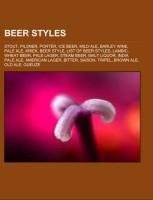
-
 Anglický jazyk
Anglický jazyk
Beer styles
Autor: Source: Wikipedia
Source: Wikipedia. Pages: 45. Chapters: Stout, Pilsner, Porter, Ice beer, Mild ale, Barley wine, Pale ale, Kriek, Beer style, List of beer styles, Lambic, Wheat beer, Pale lager, Steam beer, Malt liquor, India Pale Ale, American lager, Bitter, Saison, Tripel,... Viac o knihe
Na objednávku
15.57 €
bežná cena: 17.30 €
O knihe
Source: Wikipedia. Pages: 45. Chapters: Stout, Pilsner, Porter, Ice beer, Mild ale, Barley wine, Pale ale, Kriek, Beer style, List of beer styles, Lambic, Wheat beer, Pale lager, Steam beer, Malt liquor, India Pale Ale, American lager, Bitter, Saison, Tripel, Brown ale, Old ale, Gueuze, Cream ale, Flanders red ale, Oud bruin, Rye beer, Dubbel, American wild ale, Blonde ale, American pale ale, Vienna lager, Bière de Garde, Framboise, Kentucky Common Beer, Steinbier, High gravity beer, Sour beer, Molson Canadian 67, Amber lager. Excerpt: Beer style is a term used to differentiate and categorize beers by various factors such as colour, flavour, strength, ingredients, production method, recipe, history, or origin. The modern concept of beer style is largely based on the work of writer Michael Jackson in his 1977 book The World Guide To Beer in which he categorised a variety of beers from around the world into local style groups according to local customs and names. In 1989, Fred Eckhardt furthered Jackson's work publishing The Essentials of Beer Style. Although the systematic study of beer styles is a modern phenomenon, the practice of distinguishing between different varieties of beer is ancient, dating to at least 2000 BC. The study of what constitutes a beer's style may involve provenance, local tradition, ingredients, and/or empirical impression, which is conventionally broken down into several elements; typically - aroma, appearance, flavour and mouthfeel. The flavour may include the degree of bitterness of a beer due to bittering agents such as hops, roasted barley, or herbs; and the sweetness from the sugar present in the beer. Yeasts that ferment at relatively warmer temperatures, usually between 60 and 75 degrees Fahrenheit, form a layer of foam on the surface of the fermenting beer, which is why they are referred to as top-fermenting yeasts. Yeasts that ferment at considerably lower temperatures, around 50 degrees Fahrenheit, have the ability of to process a chemical compound known as raffinose, a complex sugar created during fermentation. These yeasts collect at the bottom of the fermenting beer and are therefore referred to as bottom-fermenting yeast. The majority of beer in production today is fermented in this way and is called lager. Two other types of beer styles include beer of spontaneous fermentation and beers of mixed origin. Beers of spontaneous fermentation are mainly produced in Belgium using wild strains of yeast. These types of beers are often referred to as Lambic. Beers of m
- Vydavateľstvo: Books LLC, Reference Series
- Rok vydania: 2020
- Formát: Paperback
- Rozmer: 246 x 189 mm
- Jazyk: Anglický jazyk
- ISBN: 9781157312970









 Nemecký jazyk
Nemecký jazyk 

 Španielsky jazyk
Španielsky jazyk 
